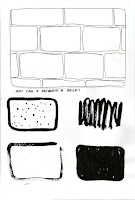I had been looking at more of Nathalie du Pasquier's drawings and here she has applied her fun and vibrant surface designs on to small scenes and characters. I really liked these images, as well as her mock-ups of clothing designs.
They aren't perfect, and don't really have a purpose but I enjoy them anyway. They are playful and interesting to me because she made them for the sake of it. Another thing I admire about her drawings is that the execution doesn't have a lot of finesse, with the majority of them being felt tip pen or pencil drawings. This adds to their character I think.
They aren't perfect, and don't really have a purpose but I enjoy them anyway. They are playful and interesting to me because she made them for the sake of it. Another thing I admire about her drawings is that the execution doesn't have a lot of finesse, with the majority of them being felt tip pen or pencil drawings. This adds to their character I think.
I did some impromptu drawings of small people wearing patterns that I had made previously. I think they are funny and cute, however this direction is just confusing things more and broadening my work when really, I need to narrow things down.
This whole idea about application is really frustrating me because I feel that it could bring me closer to resolving my ideas but I don't know how.
I wrote a list of things that worked and things that didn't work. Although it isn't bad that I have a lot of ideas, I think at this stage in the project I need to draw things together and being exploratory is doing the opposite of this.





















































